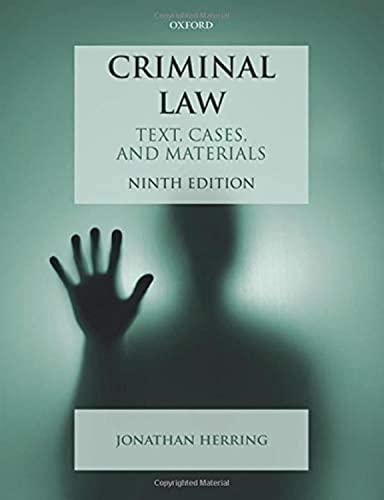Question
Applicability of Fair Use Defense Introduction: Copyrights protect the expression of creative ideas. Under Section 106 of the Copyright Act (17 United States Code Section
Applicability of Fair Use Defense
Introduction:
Copyrights protect the expression of creative ideas. Under Section 106 of the Copyright Act (17 United States Code Section 101 et al), an owner of copyright has the exclusive rights to do and to authorize any of the following:
- to reproduce (copy) the copyrighted work in copies(Links to an external site.) or phonorecords(Links to an external site.);
- to prepare derivative works based upon the copyrighted work;
- to distribute copies(Links to an external site.) or phonorecords(Links to an external site.) of the copyrighted work to the public by sale or other transfer of ownership, or by rental, lease, or lending;
- in the case of literary, musical, dramatic, and choreographic works, pantomimes, and motion pictures(Links to an external site.) and other audiovisual works(Links to an external site.), to perform (Links to an external site.)the copyrighted work publicly;(Links to an external site.)
- in the case of literary, musical, dramatic, and choreographic works, pantomimes, and pictorial, graphic, or sculptural works, including(Links to an external site.) the individual images of a motion picture or other audiovisual work, to display (Links to an external site.)the copyrighted work publicly;(Links to an external site.) and
- in the case of sound recordings(Links to an external site.), to perform (Links to an external site.)the copyrighted work publicly (Links to an external site.)by means of a digital audio transmission.
Under Section 501 of the Copyright Act, anyone who does any of the exclusive rights of the copyright owner without authorization infringes the owner's copyrights.
Concept Review:
We learned in Chapter 3 that a Defendant may provide defenses in an Answer to a Plaintiff's Complaint. A defendant frequently raises a FAIR USE defense to a Plaintiff's allegation of copyright infringement. Under Section 107 of the Copyright Act, a court may look to the following four factors when determining whether a use of a copyrighted work was a FAIR USE:
- the purpose and character of the use, including whether such use is of a commercial nature or is for nonprofit educational purposes;
- the nature of the copyrighted work (is the work mostly made up of facts or is the work mostly an original, creative work);
- the amount and substantiality of the portion used in relation to the copyrighted work as a whole; and
- the effect of the use upon the potential market for or value of the copyrighted work.
Case:
Each of us uploaded a music artist's video or a link to a music artist's video in the Introduction & Ice Breaker Activity. Under Section 106 of the Copyright Act, each of us may be liable for copyright infringement to the music artist for reproducing the music video and distributing the music video within the CANVAS Learning Management System.
Step by Step Solution
There are 3 Steps involved in it
Step: 1

Get Instant Access to Expert-Tailored Solutions
See step-by-step solutions with expert insights and AI powered tools for academic success
Step: 2

Step: 3

Ace Your Homework with AI
Get the answers you need in no time with our AI-driven, step-by-step assistance
Get Started


